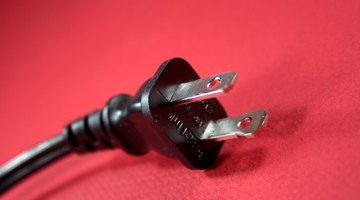Every projector uses some kind of light source to illuminate whatever medium is being projected through the lens and onto a screen. Most projectors use incandescent lamps that employ a filament suspended between two contacts in a clear glass bulb. The filament is a resistive element that can be tested with the ohms setting of a multimeter. The reason for using a meter is to make sure the lamp itself, rather than some other component in the projector, is causing the lamp not to light.
- Every projector uses some kind of light source to illuminate whatever medium is being projected through the lens and onto a screen.
- Most projectors use incandescent lamps that employ a filament suspended between two contacts in a clear glass bulb.

Unplug your projector for safety.

Remove the lamp suspected of being dead from your projector, making sure that the lamp has had time to cool off first and taking care to handle it with a soft cloth. Some lamps use a small screw base, a variation of those used in most home lighting. Still others use a bayonet-style base--the kind used in a typical old-style automotive tail light assembly. The bayonet-style base is also cylindrical, but instead of a screw thread, it has a smooth metal sleeve with two small prongs protruding sideways from the base. To remove this type of bulb, push the bulb in lightly to overcome the spring pressure in the socket, twist the bulb counterclockwise until it stops, then pull it out of the socket.
Set your multimeter to check ohms, or resistance.

Touch the two leads, usually colour-coded black for ground or negative and red for positive. On an analogue meter, the needle should swing all the way over to zero resistance. On a digital multimeter, the readout should flash briefly, then register zero. If you do not get a zero reading, move the (usually red) zero calibration wheel normally located just under the display until you do get a zero reading.
- Set your multimeter to check ohms, or resistance.
- On a digital multimeter, the readout should flash briefly, then register zero.
Place one test lead of the multimeter firmly against one contact of the lamp and the other test lead against the other contact. In a two-wire lamp, each protruding wire is a contact. In a screw-in or bayonet sleeve lamp, the metal sleeve that constitutes the base of the lamp is one contact, while the bottom tip of the lamp, the small dot separated from the sleeve by a black or brown insulator ring, is the other contact.
Note whether the needle (on an analogue meter) moves or stays still. If it moves, it will stop on a resistance reading, usually between zero and 20 ohms. A resistance reading means your lamp has continuity, or the element is fine, and should light. If the meter needle does not move, the lamp element is physically interrupted, which means it is either burnt through or broken physically. If so, it's time to replace the lamp. If you are using a digital multimeter, you should see the numbers change on the display to a low resistance reading. An interrupted lamp filament will register as infinite resistance.
- Note whether the needle (on an analogue meter) moves or stays still.
- A resistance reading means your lamp has continuity, or the element is fine, and should light.
TIP
You can purchase an inexpensive multimeter at any electronic hobbyist supply store. Never handle a lamp with bare fingers, but always with a cloth: fingerprints contain skin oil and other contaminants that can weaken the glass when it heats up, causing the lamp to fail prematurely. After testing your lamp, turn off your meter so that it will work next time you use it.
WARNING
Be careful to let the lamp cool off before removing it: it gets hot enough to cause a serious burn.
